|
|
Glaucus

|
|
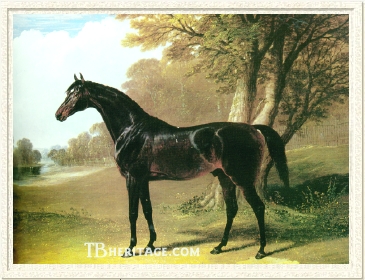 |
|
|
Glaucus was a good stayer, one of his sire's better sons on the turf. As a stallion Glaucus got two classic winning fillies in England, but his principal influence was in France, through his grandson, The Nabob, sire of three good sons who continued the Byerley Turk/Partisan sire line there for five generations.
|
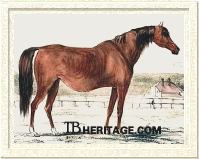
His dam, Nanine
| |
His dam, by the successful sire Selim, and out of Bizarre, by Peruvian, ran once, in the One Thousand Guineas Stakes of 1826, in which she failed to place. Like many of Selim's offspring, she was considered exceptionally attractive, with an "unusual assemblage of symmetry, substance, and high breeding." She was a chestnut, and close to sixteen hands high. She entered the Lowther Stud as a broodmare, producing seven foals there, and was sold in 1835, with a filly at foot, to the King, and placed in the Royal Stud at Hampton Court. where she got five more youngsters. Glaucus was her third foal, and her best, sold as a yearling to Lord Grosvenor, in whose colors he ran as a juvenile.
|
Glaucus on the Turf
Glaucus' sire, Partisan, was a moderately good race horse that became an influential sire in England and Europe.
Like all of Partisan's offspring, Glaucus had the misfortune to be born during the nadir of British horse racing, when bribes, fraud, and tampering had become common, and Glaucus at age three also was unlucky enough to fall into the hands of one of the more questionable turfites of the era, Robert Ridsdale. Ridsdale rose from humble origins via bribes and corruption, to become a major player on the turf in the 1820s and '30s. Horses owned by Ridsdale and his one-time croney, John Gulley, might win, or they might not, depending on the odds and subsequent wagers of their owner (see also Partisan, St. Giles).
Running for Grosvenor, Glaucus won his first race, a sweepstakes at Stockbridge, beating Dangerous, who won the Derby the following year. His next race, in October, was the Prendergast Stakes at Newmarket, which he won over a top field; this was followed by second place in the Criterion Stakes, beaten by a length by the Lavant Stakes winner Weeper. His last race of the year was a 500 guineas match against Newmarket Clearwell Stakes winner Clearwell, which he won. His prospects for the classics, based on his juvenile record, were very bright.
However, Glaucus was sold to the high-stakes gambler Robert Ridsdale for whom he ran twice in his three-year-old year -- the Derby and the Doncaster St. Leger. He did not place in either, although he was odds-on favorite for the Derby and had easily beaten the winner, Dangerous, at age 2. He was never in the running in the St. Leger, won by Rockingham, a horse Glaucus beat the following year in the Ascot Gold Cup.
At the end of the year Glaucus was purchased by George Stanhope, Earl of Chesterfield; his speed and courage were quickly reasserted under new ownership. He began his third season by winning the Claret Stakes at Newmarket. He lost a match against The Saddler, but this was followed by a huge win in the Ascot Gold Cup, beating some top horses, including the St. Leger winner, Rockingham. The same day he won the Eclipse Foot in a race for Jockey Club member horses only over the Cup course of two and one-half miles, beating the fresh Gallopade, who had won the race the previous year. He then won a 3 mile-5 furlong race at Goodwood. In October he placed second to Glencoe in the Garden Stakes at Newmarket. At the end of the meet there Chesterfield challenged with Glaucus for The Whip, and received it, unopposed.
At age five, his season began with a loss in the Craven Stakes. He went on to Goodwood, winning the Goodwood Stakes, beating that year's Oaks and 1,000 Guineas winner Preserve, and several others, in a thrilling finish. He ran second to Rockingham in the Gold Cup, and lost to Muley Moloch in the Doncaster Stakes. His last race of the season was the Hornby Castle Stakes, where he bested Muley-Moloch, who broke down in the running. At age six he was entered in two 50 sovereign races at Newmarket first spring, both of which he won in a walk-over. He was then retired to stud.
|
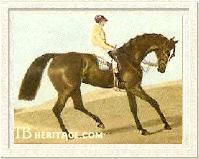
Glaucus daughter Refraction won the Oaks
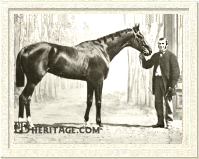
Vermout, a grand stayer and sire, continued the Partisan sire line in France
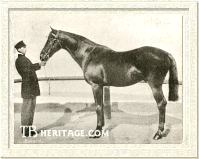
Boïard, one of Vermout's top sons
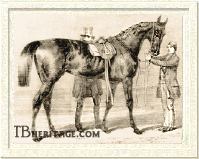
Rupee, a staying great-granddaughter
| |
Glaucus in the Stud
Glaucus got two classic winning daughters, both born in 1842, and a son who continued the Partisan sire line in France. PIC-NIC, from the Brutandorf mare Estelle, won the 1,000 Guineas; in the stud she produced another Guineas winner, Mayonaise, and her female line (Family 3 - l) has continued to produce classic and other stakes winners to the present. Glaucus' second good daughter was REFRACTION, who won the Oaks in 1842, and was purchased in 1852 by M.A. Lupin and sent to France. Out of Prism, by Camel, she later produced La Maladetta (by The Baron), who won the Grosser Preis von Baden, and this female line continued to produce stakes winners well into the 20th century.
Glaucus also got a son, THE NOB (1838), a moderately good race horse who ran second to Beeswing in the 1842 Ascot Gold Cup. The Nob was retired to Harvey Combe's Cobham Park in Surrey. Combe was owner of Watney, Reed and Combe brewery.
The Nob's son, The Nabob (1849), was bred by Colonel (later Major-General) Jonathan Peel, the younger brother of Tory Prime Minister Sir Robert Peel, a long-time fixture on the British turf, and a prominent member of the Jockey Club. The Nabob (from Hester by Camel) was bred at Hampton Court, where Peel had his breeding establishment. He was a handsome black horse, close to 16 hands tall, who won seven of his 26 races, including the Chesterfield Cup at age 4, and placed second in some good races, including the Cambridgeshire Stakes and the Cesarewitch Stakes. In 1857 he was purchased by Baron Arthur Schickler for 30,000 francs and sent to his stud in France, at that time located in the Bois de Boulogne in Paris.
In France The Nabob got three good racing sons, Bois Roussel (1861, Prix du Jockey Club), Suzerain (1865, Prix du Jockey Club, prix de l'Empereur and others), and Vermout (sometimes spelled Vermouth) (1861, Grand Prix de Paris). Vermout got two French Oaks winner and Enguerrande (1873) who tied for the win of the Epsom Oaks, and some good sons, including Boïard, who won both the Prix du Jockey Club and the Grand Prix de Paris, and Perplexe, sire of two good classic winning colts. The Nabob also sired Rupee (1857), a brown filly from Bravery by Gameboy, winner of the Ascot New Stakes, the Biennial at Ascot and the Ascot Gold Cup.
|
Despite his two classic winners, Glaucus was not a successful sire. After the 1843 season he was sold to Mecklenburg (Germany), where he was of minor use as a stallion. A daughter of 1847, Brown Bess, was the dam of Atalante (filly, 1857, by Blackdrop) and Meleanger (1858, by Blackdrop), both winners of the 1200 meter Zukunfts-Rennen, of Bellario (1862, by Blackdrop), winner of the 2200 meter Union-Rennen, and of Bessy Bird, dam of two winners of the Preis der Diana (German Oaks).
--Patricia Erigero
|
|
|
|

